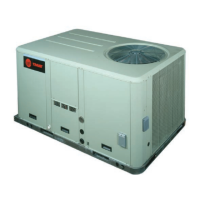12 RT-SVX21AC-EN
General Information
Unit Inspection
As soon as the unit arrives at the job site
• Verify that the nameplate data matches the data on the
sales or
der and bill of lading (including electrical data).
• Verify that the power supply complies
with the unit
nameplate specifications.
• Visually inspect the exterior of the unit, including the
roof, fo
r signs of shipping damage.
If the job site inspection of the unit reveals damage or
mate
rial shortages, file a claim with
the carrier
immediately. Specify the type and extent of the damage on
the “bill of lading” before signing.
• Visually inspect the internal components for shipping
d
ama
ge as soon as possible after delivery and before
it is stored. Do not walk on the sheet metal base pans.
• If concealed damage is discovered, notify the carrier’s
term
inal o
f damage immediately by phone and by
mail. Concealed damage must be reported within 15
days.
• Request an immediate joint inspection of the damage
by
the ca
rrier and the consignee. Do not remove
damaged material from the receiving location. Take
photos of the damage, if possible. The owner must
provide reasonable evidence that the damage did not
occur after delivery.
• Notify the appropriate sales representative before
in
stalling
or repairing a damaged unit.
Storage
Take precautions to prevent condensate from forming
inside the unit’s electrical compartments and motors if:
1. the unit is stored before it is installed; or,
2. the unit is set on the roof curb, and temporary heat is
pr
ovided in the building. Isolate all side panel service
entrances and base pan openings (e.g., conduit holes,
Supply Air and Return Air openings, and flue
openings) from the ambient air until the unit is ready
for start-up.
Note: Do n
ot use the
unit’s heater for temporary heat
without first completing the start-up procedure
detailed under “Unit Start-Up,” p. 53”.
The manufacturer will not assume
any responsibility for
equipm
ent damage resulting from condensate
accumulation on the unit’s electrical and/or mechanical
components.
Unit Nameplate
A Mylar unit nameplate is located on the unit’s corner
support next to the filter access panel. It includes the unit
model number, serial number, electrical characteristics,
refrigerant charge, as well as other pertinent unit data.
Compressor Nameplate
The nameplate for the compressors are located on the side
of the compressor.
Microchannel Coil Barcode ID
Barcode decal used for coil part identification can be
located on the header and top of coil's inlet/outlet side.
Unit Description
Before shipment, each unit is leak tested, dehydrated,
charged with refrigerant and compressor oil, and run
tested for proper control operation.
The condenser coils are either aluminum fin, mechanically
bo
nded to
copper tubing or all aluminum microchannel.
Direct-drive, vertical discharge condenser fans are
provid
ed with built-in thermal overload protection.
There are two control systems offered fo
r these units. The
electromechanical control option uses a thermostat to
perform unit functions. The ReliaTel™ Control Module is a
microelectronic control system that is referred to as
“Refrigeration Module” (RTRM). The acronym RTRM is
used extensively throughout this document when
referring to the control system network.
These modules through Proportional/Integral control
al
gorithms perform specific unit functions that governs
unit operation in response to; zone temperature, supply air
temperature, and/or humidity conditions depending on
the application. The stages of capacity control for these
units are achieved by starting and stopping the
compressors.
The RTRM is mounted in the control panel and is factory
wired
to the respective internal components. The RTRM
receives and interprets information from other unit
modules, sensors, remote panels, and customer binary
contacts to satisfy the applicable request for cooling.
Economizer Control Actuator (Optional)
Electromechanical Control
The ECA monitors the mixed air temperature, ambient dry
bulb temperature and local minimum position setpoint
sensors, if selected, to control dampers to an accuracy of
+/- 5% of stroke. The actuator is spring returned to the
closed position any time that power is lost to the unit. It is
capable of delivering up to 25 inch pounds of torque and
is powered by 24 Vac.
ReliaTel™ Control
The ECA monitors the mixed air temperature, return air
temperature, minimum position setpoint (local or
remote), power exhaust setpoint, CO
2
setpoint, CO
2
, and
ambient dry bulb/enthalpy sensor or comparative
humidity (return air humidity against ambient humidity)
sensors, if selected, to control dampers to an accuracy of

